Recently, my little family has enjoyed some unexpected wins with limiting screentime! And since I know this is a battle many other families are also fighting, I thought I’d do a little public service and share what’s working well for us right now.
(Because every kid, every household, and every tech setup is different; and growing kids and evolving technology mean that things will continually change.)
I’ll share our situation so you know where I’m coming from (and how it might be different for you) and then I’ll get into what we’ve implemented. I’ll also share some of the results we’ve noticed, but spoiler alert… things are surprisingly good right now!
Side note: Technically this is way off topic from my usual blogs on here, but since many of my clients and fellow writers are in a similar phase of parenting, I thought it might be just as useful as the other stuff I write about! And not entirely unrelated to the technology topics I often cover for clients.
The Situation
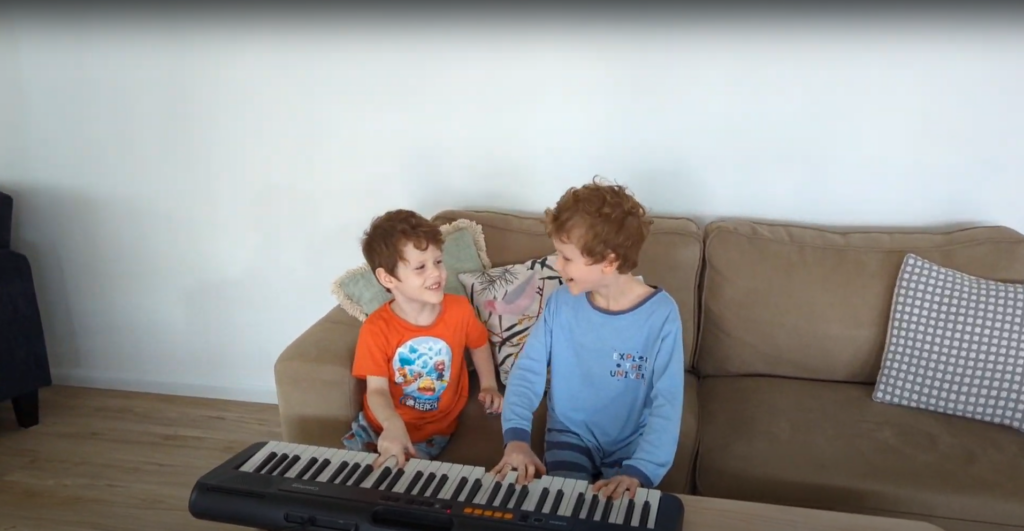
Let me set the scene for you. My husband (Stew) and I have two young boys — ages 5 and 7. They each have a fairly basic Samsung Tablet and share access to the TV which is linked to Netflix, Amazon Prime, YouTube Kids, Nintendo Switch, and a WiiU.
The older kid can figure out how to read/type most things. Both kids are extremely savvy at navigating interfaces. If an app or setting is available, they will find it and play around with it.
Both kids also like to test the boundaries and be sneaky about things if given the chance. I include this detail because if you have a kid like this, you’ll know that you have to be one step ahead with everything. Asking them not to do something is not enough to protect them — in fact, they’ll probably go ahead and try to do exactly the thing they’re not meant to be doing. And if you don’t have a kid like this, you’ll probably think everything I say here is overkill.
The Struggle
Over the last couple of years, we’ve had quite a few struggles with screen time. Perhaps more than some due to the stubborn personalities that live in this household. Also not helped by a global pandemic that made it kinda hard to leave the house for a while.
Anyway, the kids wanted more. More Switch. More tablet time. And (less so nowadays) more Netflix/TV.
As parents, we felt conflicted about this because screens can be good (sometimes necessary), but also often quite bad (with potentially massive consequences).
Screen Time: The Good
Screens can actually be quite good for our family. Here are some benefits I’ve noticed:
- Breaks – They’re useful tools for us to get a break from the intensity that comes with small people. When our kids are occupied by a screen, they are generally a lot less demanding.
- Relaxation – Our kids are also sometimes soothed and relaxed by playing games or watching videos. And I think they particularly like the feeling of being in control of a character or a world (after all, kids often have very little control over the real world).
- Skills building – Tech skills are really useful for kids to learn and we don’t want to get in the way of that. Plus, there are a lot of opportunities for kids to learn via apps and even their favourite games. The older child may have refused to read books over the holidays, but he certainly read a lot of on-screen dialogue while playing the Switch!
- Bonding – Playing a game or watching a movie together can be a great way to bond. The kids often help each other (or get Stew to help them) through tricky games. They enjoy watching each other play and particularly enjoy it when we all watch a movie or show together.
- Friendships and conversations – Friendships are built on shared interests, and at their age, most kids are interested in screens! Our kids often talk to their school friends (including kids in other grades) about the games they play and shows they watch, and in these conversations, you’ll really see them come out of their shell.
- Motivation – Screen time can be a useful reward or motivator for getting through less-than-pleasant activities.
Plus, Stew and I are at our computers a lot for work, and we do spend a lot of time on our phones — learning stuff, connecting with family, hunting down that next Marketplace find, and soothing/entertaining our frazzled brains. It’s only natural that the kids might follow our example.
Screen Time: The Bad
Of course, the screens are often bad, too. Some of the negatives I’ve noticed include:
- Shaky boundaries – It’s really easy to slip into longer (and even unrestricted) screen time when we’re sick or overtired, or something messes with our usual routines. Particularly because getting kids off the screen and enforcing that boundary can require a lot of energy in the moment.
- Boredom – We’ve noticed after days where the kids had a lot of access to screens, they were more whiny, less able to entertain themselves (once screens were not available), and their emotions were all over the place.
- Inactivity – More screen time means less moving their bodies, exploring outside, and doing creative, hands-on things.
- Explosiveness – Trying to take away or turn off a screen can lead to big emotions that can make transitioning to other activities (school, meal time, shower, bed) even harder.
And although we haven’t personally experienced this, we know that screens have the potential to be bad in other, more serious ways. Stew and I are likely more protective of our kids than average, but we’re very aware of what’s possible on an internet-connected device.
We’re concerned about things like:
- Access to content that’s not suitable for kids and against our values
- Information sharing capabilities in some apps
- The need to protect our family’s privacy
- Communication tools and the potential for our kids to send or receive a photo or comment that causes harm
- The potential to connect with people on the internet
Any of the above things can happen in an instant. What’s seen cannot be unseen, what goes on the internet is there forever, and the risk is very real.
The Solution: Setting Healthy Boundaries
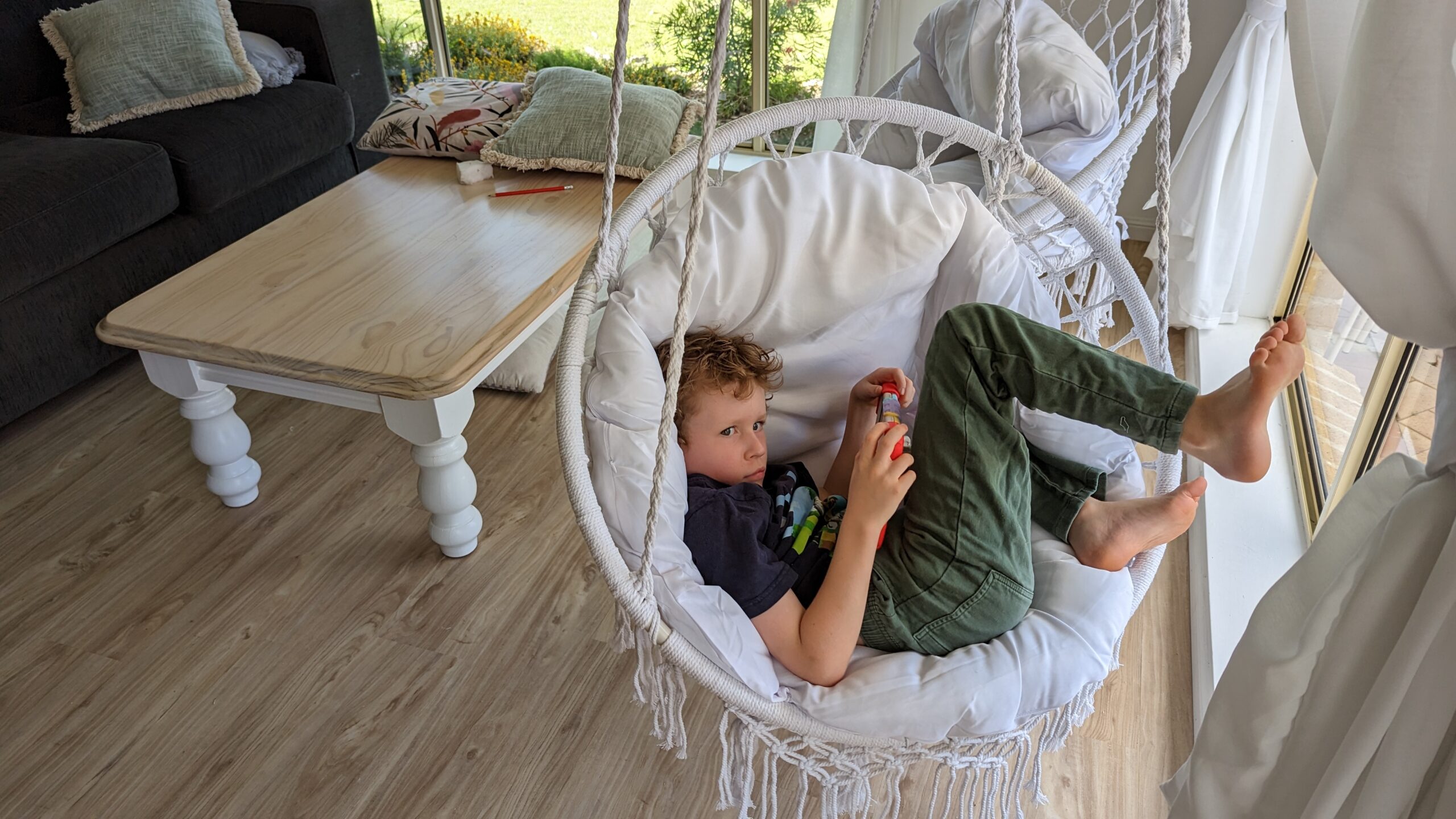
Our kids now (finally!) understand that they can’t just go running across a busy road. They are starting to comprehend some physical consequences and risks. But they definitely don’t have that understanding when it comes to internet-connected devices. And at their age, it’s also not appropriate for me to even explain all the risks to them — I need to carry certain heavy things until they’re big enough to handle the load.
This means we will need to hold their hands for quite some time when it comes to screens.
With that in mind, we’ve experimented with a few different approaches and have finally found a combination that is working relatively well for our family, restricting both access and time on devices.
In case you want more specifics about how we’re doing this, I’ll expand on the details below.
1. Restricted Access
When our oldest was still a baby, we were introduced to this idea of creating a “yes” space. In essence, this involves setting up a space where you don’t have to constantly follow your kid around and say no to them. You put things up high, put locks on doors, anchor your furniture, and so on. It means you can relax a bit more, knowing that they’re safe to explore — and they aren’t constantly hearing “no”. (And FYI, this was an absolute lifesaver because our first kid was into everything.)
Now that our kids are older, they can generally be trusted not to lick the toilet brush and escape out the front door when I’m not looking. But they definitely cannot be trusted to act appropriately on an unrestricted screen.
Restricting their access is all about creating a “yes” space on screens. In other words, we remove their ability to do or see anything that isn’t first approved as safe for them (as much as possible). Here’s how:
- Passwords – We have passwords set up so that we have to first log into the Switch before they can play.
- Kids accounts – We set up a Netflix Kids account where the highest rating is G-rated. This isn’t a perfect solution, but we determined that a large portion of PG-rated shows are unsuitable, while most G-rated ones are ok. It also allows us to block specific shows/movies. The adult Netflix accounts are password protected.
- Pins – We have pin locks on their tablets so they have to ask us to unlock them. And of course, our own phones are pin locked, too.
- Limited search and media – On the tablets, they don’t have access to YouTube or a browser. We actually removed YouTube Kids because we weren’t satisfied with the parental controls. The problem was that it was too hard to add/remove content, and some of the content our kids want to watch (that is appropriate) isn’t available on YouTube Kids.
- App requests – If they would like to download an app, they need to send a request to Stew or I so we can first check and approve it via a notification on our phones. Sometimes after a quick play, we end up removing the app if it appears too violent, has too many annoying ads, or has a multiplayer/communication element we weren’t aware of.
- Approved media only – We use a media player that allows us to add pre-approved videos that our kids can choose from and watch. Because they mostly like watching YouTube gamers, we carefully check these accounts before approving their content to ensure the topics and language are appropriate.
Restrictions at DNS level – We also use a service called NextDNS.io. This allows us to control all traffic that comes into the tablet in a more granular way. We can block specific apps, domains, IP addresses, and advertising services. It also keeps a log of all incoming queries and what has been accepted and rejected. For now, we only have this set up on their tablets under the ‘Private DNS’ settings, but there are similar solutions we can use at a network level (i.e. any devices in the home) in the future for when we need to cast a wider web (and they start outsmarting us).
2. Limiting Screentime
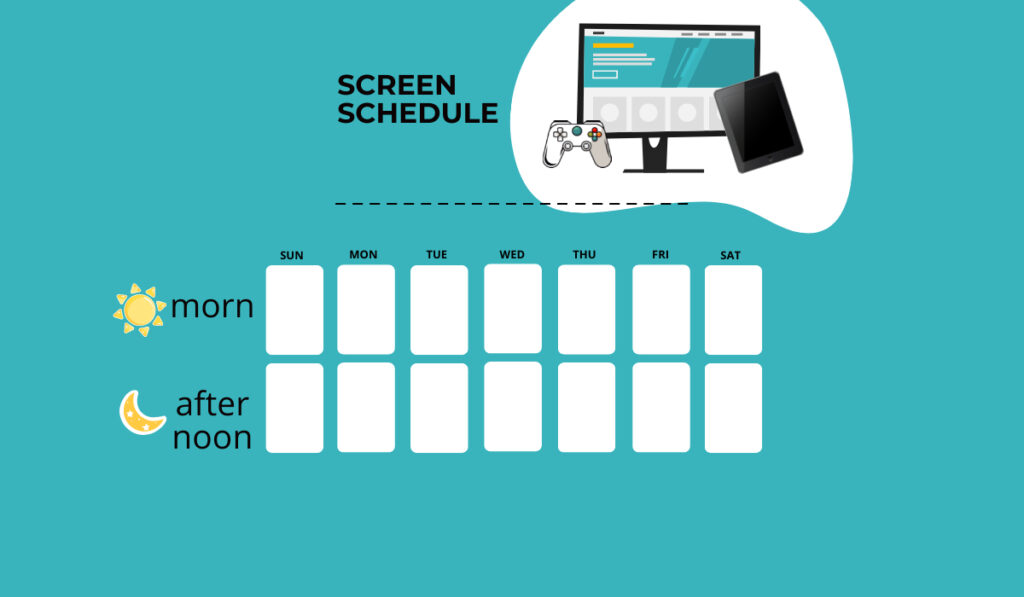
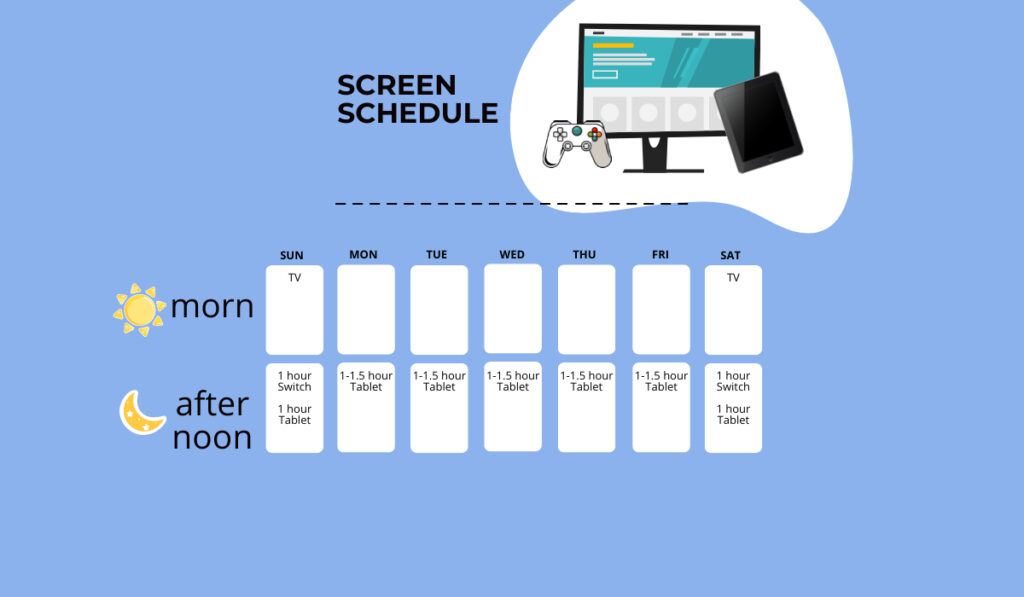
⬆ Here’s roughly what our screen time looks like in a week. Scroll through — I’ve added a blank version you’re welcome to save/print/fill.
For all the good things that can come from screens, they can quickly become too much of a good thing. Even a lot of adults really struggle to regulate our screen time, so we really can’t expect kids to do this for themselves.
Upon reflection, most of the negatives we’ve experienced happen following an overdose of screens — for us, that’s generally anything over two hours per child, per day. Though potentially, some extra time on weekends watching TV or a movie seems ok, especially if it’s a shared experience.
With this in mind, we’ve had to set time limits. We’ve attempted to do this *many* times and I feel like we’ve only just now cracked the code. Here’s what we do:
- Relaxed weekends and holidays – On weekends or holidays, the kids can watch Netflix Kids in the morning when they wake up (because… hello, sleep in!). During the day, they each have one hour of Switch and one hour of tablet time. They often choose to split this up into half hour sessions to spread it out over the day.
- Strict school mornings – We hide the TV remote so they can’t watch Netflix before school. The kids have to complete a checklist of four items to get ready in the morning (e.g. eat breakfast, brush teeth). Each completed item earns them 15 minutes of tablet time. For each minute that they are fully ready for school before scheduled departure, they get a bonus minute (up to 30 minutes). But they can’t use any of this time until the afternoon.
- Screens on school afternoons – On school afternoons, the kids must first complete any homework for the day and have a bath/shower. After this, they are free to use their tablets until time runs out (or until dinner/bed if it’s getting late).
- Automatic time limits – We use a parent control app on our phones to program this time limit into their tablets so that they stop functioning once time is up (much easier than trying to enforce these limits in the moment).
- Extra time – On some weekends, we will negotiate extra screen time as a reward for being helpful.
- Lost privileges – Sometimes we will threaten or enforce a consequence that reduces or removes their allocated screen time, if necessary.
Side note: Because this is quite complicated (various rules and different rules for different days), it would probably work best with kids that can read a schedule and follow written rules. I suspect that the thing that has helped our kids *get it* is that we introduced the rules and routine bit by bit.
Of course, depending on how you see it, this schedule can still add up to being a fair bit of screen time. But I have noticed a huge change in our kids since implementing it. And lately we’ve noticed our kids are choosing to do other things on weekdays, even when their screens are available. In the last week, the older one averaged 48 minutes per day, and the younger one just 14 minutes per day.
The Results

So, what’s changed since implementing the above solutions? So. Many. Things.
The Kids Have Adapted
The kids don’t like having their access restricted, of course. Some games they want to play don’t work (e.g. they can’t earn points) because the ads are blocked by the DNS settings. But we’re firm on our boundaries and know that one day they will understand why. Over time, they have gotten used to the limits and found plenty of things they love doing within those limits.
We’ve Relaxed
One of the best things about making the tablet a “yes space” is that we don’t have to hover over our kids constantly while they’re on the screens. Because we know they can’t get up to anything too harmful, we can do our own thing (work, rest, relax) while they do their thing.
More Motivation
Because it’s tied to their screen time, the kids are very motivated in the mornings to get ready for school. Previously, this was beyond difficult… I’d need a whole other blog to really explain. The mornings aren’t perfect, but they’re so much better than before and it’s making a real difference to how we all start our day. They’re also motivated to do homework and get bathed because we won’t unlock their screens until both these tasks are done.
Greater Sense of Control
The kids seem really happy to have some control over their allocated time by earning “bonus time” and choosing when to hop on. They’re often delaying their screen time and doing other activities indoors or outdoors first — which sometimes means that they don’t even use the full amount of time allocated before bed. And surprisingly, they’re not too bothered when that happens.
Self-Reflection and New Habits
I’m also starting to limit screentime for myself using Google’s Digital Wellbeing tool. I noticed that I was doing a lot of mindless scrolling on certain apps, so I set daily limits on these. After 30 minutes or an hour, they stop working until the next day. This is better for my own body and brain, of course, but also important that I model the kind of expectations I have for my children. (Imagine their shock when I said, “I hope I can show you this funny video I found as I think my timer is nearly up for today!”)
Things Still to Figure Out
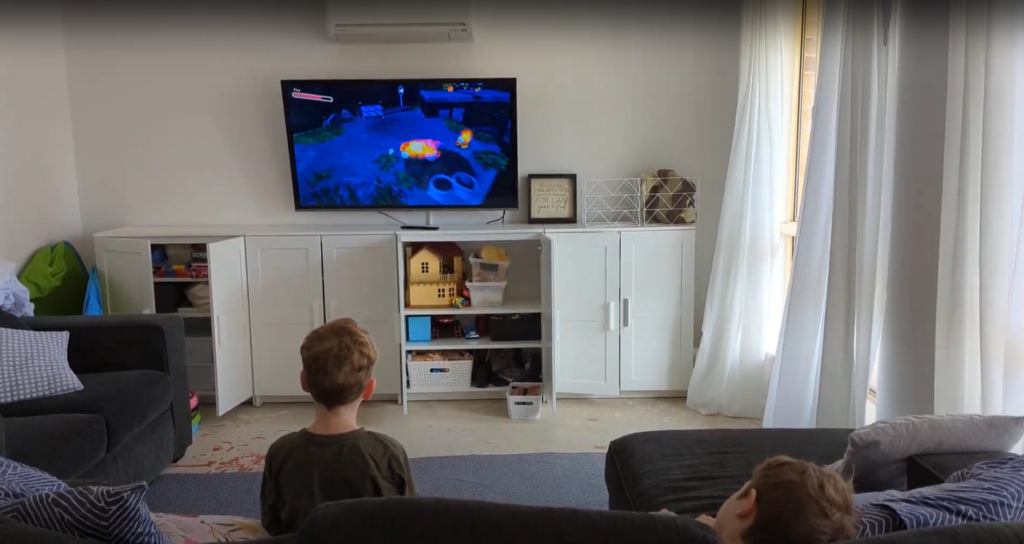
Of course, there is no perfect solution. There are still holes in this that we haven’t 100% plugged and things we’ll need to navigate in future. For example…
Filters
We have no control over what shows up when our kids browse for new apps, other than relying on Google Play to filter the content for us based on the level of restrictions we’ve set.
I’m sure there’s other holes like this that we will discover over time. Or maybe you’ve already thought of one? Please share in the comments!
Messenger Kids
We have our kids on Messenger Kids, where we have to first approve all contacts and can monitor what’s being sent. The contacts are mostly close family members at this stage, aside from one school friend. It’s quite cool that they can potentially send and receive messages with grandparents, aunts, and uncles. But there’s a slight chance that our kids might make a poor choice about what to send, and we may not know until it’s too late. The risk will increase if and when our kids are allowed to connect with more friends — and those friends might also make poor choices. There is also a small chance that someone we approve may get their account hacked and then that person could message our kids.
Balancing Work and Play
Another thing is that our kids are only 5 and 7. Right now, screens are all about fun and games because they don’t have homework or assignments that require them to use the internet for research or writing.
In future, we will need to look at how we can integrate school tasks, while maintaining limits on leisure time. We’ll likely need to provide them supervised access to Google, YouTube, and other things — with some restrictions on search and content.
So, if you’re already in this phase with your kids and have a good system going, let me know!
Staying One Step Ahead
Our kids are already extremely tech-savvy and that will only continue.
I remember when we were growing up with the internet, it didn’t take long at all before we could do everything our parents could, and a whole lot more. Once I hit CTRL-ALT-DELETE to hide my screen in a split second and while my own mother was looking over my shoulder, I used task manager to close what I was doing. She knew I’d done something shifty but had no idea of knowing what that something was Knowing me (a curious but very sheltered kid), I was probably looking up something I’d heard at school to figure out what it meant.
Meanwhile, I think Stew was only 13 when he was downloading and then illegally hosting Simpsons episodes for people to watch on a random free website he made, just for the fun of it. I’m not sure his parents knew anything about it at all.
Thankfully, Stew and I ended up relatively unscathed, despite our sneaky, dodgy ways. It does help that the internet was a lot smaller back then and devices weren’t so integrated into every waking moment — and certainly not when we were super small.
At this point, we’re still way ahead of our kids on technology (especially Stew) but there may come a day when they figure out workarounds. Hopefully not until they’re old enough to make good choices, though…
Transitioning to Adulthood
Eventually, our kids are going to grow up and we won’t be able to hold their hands anymore when it comes to the internet.
I suspect that as we approach the mid-late teens and they get their own devices, we’ll gradually ease back on most restrictions. Perhaps we’ll just have some general internet filters for the household and the slight possibility that someone might see your search history.
By then, we’ll have had some age-appropriate conversations about what’s out there in the internet world, what to avoid, and why. And after that, it’ll be over to my kids to make their choices with their screen time and devices, and I’ll just have to cross my fingers that the patterns we’ve created in the early years will give them a good path to follow.
That’s a whole 10+ years away, though. And although kids grow up quickly, in internet years… that’s forever.
What’s Working For You?
Hopefully this has been an interesting read for you — I suppose if you’ve read this far, you’ve gotten something out of it!
Please feel free to chime in and add your comments below because I’d love to know…
What restrictions, limits, and technologies have helped your family screen time? And how have you adapted these as your kids got older?

